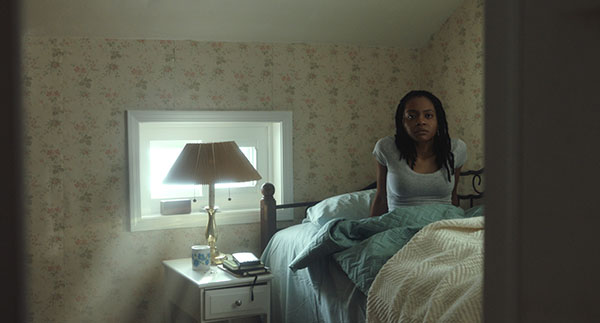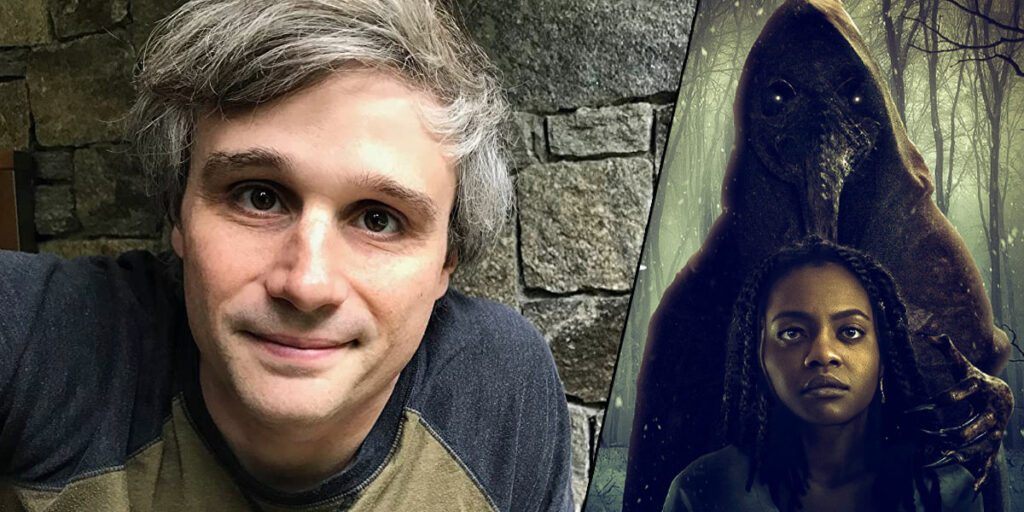We interview The Harbinger director Andy Mitton about the challenges of directing during a pandemic and the creative process of his acclaimed horror film.
The Harbinger is an ambitious and chilling horror film made during the Covid-19 pandemic that examines existential paranoia and takes its small budget trappings on a surreal journey that reflects our anxieties of quarantines and isolation. It’s a film crafted with passion amidst a mountain of challenges that came out on the other side as a worthy entry of pandemic cinema.
The film follows Monique (Gabby Beans), who steps out of her family quarantine to comfort her friend Wendy (Laura Heisler), who is suffering from horrific nightmares. As Monique travels to the city to help a friend in need, a discovery is made that Wendy’s nightmares may be contagious and Monique’s instinctive decision may have put them both in danger.
In conjunction with The Harbinger ’s UK digital release on 23rd January, we had an interview with director Andy Mitton about the process of making a low budget horror film during a pandemic, the challenges that brings, and what might be next on the horizon.
Andy Mitton on The Shooting Process of The Harbinger
What Was The Inspiration of The Harbinger?
Andy Mitton: I wrote it during the early days of COVID-19, in the summer of 2020. There had been another movie we were expecting to shoot that wasn’t going to be possible. We didn’t see a finish line at that point, and so it was a processing of those feelings. It was a combination of some story ideas that had been swirling around for a while, and the collective well of dread during that time fueled those ideas. It glued these things together. One night in August of 2020, it came to me really suddenly, which led to debates with my production partners about whether it was a good idea to set it in that time or whether we needed to find a parallel space. In the end, we let the inspiration be the inspiration and trust that if we deliver the goods to the horror community, they’re going to look at the truth behind it and they’re going to take it on.
What was it like filming in the middle of a pandemic?
A.M.: It was really hard. There was a lot to adjust to with no time to adjust to it. The COVID testing was the thing that gave us some peace of mind. Once your company tests negative on day one, you know no one’s going anywhere for a few days, so you can relax a little bit and get in the zone. There were air filters playing through in between takes that were really loud. We were unable to read people’s expressions after a take, all those things took adjusting to. But also, I think it bonded us. It was an on location shoot, which you always get kind of a family vibe out of and I think it enhanced that. We needed each other. We had no safety net and only 14 days to shoot, so we were a tight little family.

The heart and atmosphere of The Harbinger
The heart of The Harbinger comes from the chemistry between the character of Monique and Mavis. Was there any work prior to filming to create a tighter chemistry between the two actresses?
Andy Mitton: Normally, I like to rehearse prior to shooting. I’m just sort of a theater animal that way. But in this case, like everything else, it went to zoom. At first, that sort of bummed me out. Then I realized this was actually good, because it was easier to get everyone together and we could just talk about our experiences coming into it from our little boxes. I think it did help the chemistry along. But there’s sort of an alchemy and a luck to that, too. I mean, Emily Davis and Gabby Beans, who are the leads of the film, are fantastic. They are two of the best upcoming actors in the stage scene in New York. They had some awareness of each other. I think they knew the energies would play off. So once I saw it all clicking, I just got out of the way.
Dreams are a driving force for a lot of the film’s horror and atmosphere. Was there any particular dream you had prior to making the film that may have served as inspiration both narratively or visually?
A:M.: I think so. I think it’s a combination of whatever seeped in. There were a few of my dreams and then you also, as a writer, start to apply dream logic and let that lead you from one thing to another, which is a fun exercise. The shooting script was rewritten after we knew the location, so there were things in the original script that probably were more true to dreams that I had. I wrote them out because we ended up getting this old decrepit opera house to shoot in, and it had all these amazing little locations within it. I thought the wiser thing to do, especially with budget restraints, was to go walk around that space and sort of rewrite the dream sequences to suit where we physically were. It was a combination of all those things that came together.
The Challenges of The Filmmaking Process and what’s next for Andy Mitton
For The Harbinger, you were the director, writer, editor and composer. What challenges are introduced as a filmmaker when involved within each aspect of a production?
Andy Mitton: It’s a minefield of dangers and challenges. I think it requires a baseline of humility and a willingness to be more collaborative to safeguard against the potential tunnel vision, rabbit hole, head up your own ass, situations you can get into. The way I always look at it is when I’m directing, I cannot be protecting the script. I have to hate the writer a bit. Similarly to editing, I have to just be really frustrated with the director and remember that in all these phases, it gets made again. If you’re just protecting the previous version, you’re not playing the game right and I’m constantly looking around to my collaborators and inviting them to police me and to bring fresh eyes into the process. All those things are necessary, but I’m really not the control freak auteur that the question would sort of imply that I am. This was my most collaborative process because of how scared I was of that reality.
What advice would you give to young filmmakers in a post pandemic world?
A.M.: I know some very wise people who tell young filmmakers to write anything and don’t think about the budget constraints or the constraints of our world. I sort of feel the opposite. I enjoy constraints. I think constraints can inspire creativity. Now, granted, I would like less constraints than I’ve had. It would be nice to have more time to shoot, more resources, etc. But the world we’re in and the sort of limitations to what you can do can inspire great things if you acknowledge them in your dreaming and planning and scheming. They don’t have to be walls. They can be doors.
Is there anything you can say regarding any future projects in the pipeline?
A.M.: I can say that I have a lot of lines in the water right now. One thing that’s in early development is a cosmic horror story that takes place during a solar flare. I won’t say too much about it because I’m old enough now to be jaded and have the superstition that if I say it out loud too clearly, it would go away. The pandemic was good for writing, so I’ve got my stack of scripts, I’ve got my take on all the subgenres. I’ve been meeting wonderful people through this process which was meant to be a bridge builder to the next chapter. So all signs are pointing in a good direction, but yeah, nothing super specific yet.
This interview was edited for length and clarity.
FrightFest Presents and Signature Entertainment released The Harbinger on Digital Platforms 23rd January, 2023.

